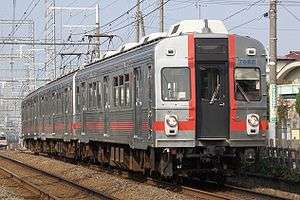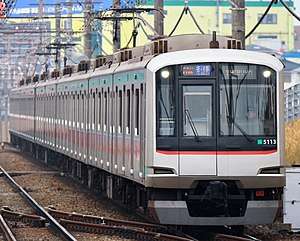Tokyu 7600 series
The Tokyu 7600 series (東急7600系, Tōkyū 7600-kei) was a commuter electric multiple unit (EMU) train type operated by the private railway operator Tokyu Corporation in Japan from 1 May 1986 until 10 February 2015. They were all rebuilt from 7200 series trains dating from 1967 to 1972.[1]
| Tokyu 7600 series | |
|---|---|
 A 7600 series EMU running between Kugahara Station and Ontakesan Station on the Tokyu Ikegami Line | |
| In service | May 1986 – February 2015 |
| Constructed | 1986-1990 |
| Entered service | 1 May 1986 |
| Number built | 3 sets (9 cars) |
| Number in service | None |
| Number preserved | None |
| Number scrapped | 3 sets (9 cars) |
| Formation | 3 cars per trainset |
| Operator(s) | Tokyu Corporation |
| Line(s) served | Tokyu Tamagawa Line, Tokyu Ikegami Line |
| Specifications | |
| Car body construction | Stainless steel |
| Car length | 18 m (59 ft 5⁄8 in) |
| Doors | 3 pairs per side |
| Traction system | Variable frequency (GTO) |
| Electric system(s) | 1,500 V DC Overhead line |
| Current collection method | Pantograph |
| Track gauge | 1,067 mm (3 ft 6 in) |
Design
Cars were 18 m long, all made of stainless steel, with longitudinal seating. Two three-car sets were formed in 1986, followed by a third set in 1990.[1]
Operations
These trains initially operated on the Mekama Line and Ōimachi Line. They were later concentrated on the Ikegami Line and used with the 7200 series. The 7600 series trains were used on the Tamagawa Line and Ikegami Line. A special farewell event for the 7600 series was held on 7 February 2015,[2] and they were finally withdrawn on 10 February the same year.
Formations
As of 1 April 2014, two three-car sets were in service, formed as shown below, with two motored ("M") cars and one non-powered trailer ("T") car, and car 1 at the Gotanda/Tamagawa end.[3]
| Car No. | 1 | 2 | 3 |
|---|---|---|---|
| Designation | Tc | M | Mc |
| Numbering | 7600 | 7680 | 7660 |
Car 2 had two lozenge-type pantographs.[3]
Livery variations
From November 2014, set 7601 was returned to service after overhaul in the plain unpainted stainless steel livery formerly carried by the 7200 series trains.[4]
References
| Wikimedia Commons has media related to Tōkyū 7600 series. |
- 私鉄車両年鑑 2013: 大手15社営業用車両完全網羅 私鉄車両年鑑2013 [Japan Private Railways Annual 2013]. Tokyo, Japan: Ikaros Publications Ltd. 20 March 2013. p. 179. ISBN 978-4-86320-693-9.
- 2月7日(土)に池上線・東急多摩川線蒲田駅構内で「ありがとう7600系イベント」を開催します ["Arigato 7600 series" event to be held on February 7 on the Ikegami Line] (PDF). Tokyu (in Japanese). Japan: Tokyu Corporation. 29 January 2015. Retrieved 21 April 2017.
- 私鉄車両編成表 2014 [Private Railway Rolling Stock Formations - 2014]. Japan: Kotsu Shimbunsha. 24 July 2014. p. 60. ISBN 978-4-330-48414-3.
- 東急7600系がクラシックスタイルに [Tokyu 7600 series in classic style]. Japan Railfan Magazine Online (in Japanese). Japan: Koyusha Co., Ltd. 28 November 2014. Retrieved 29 November 2014.
